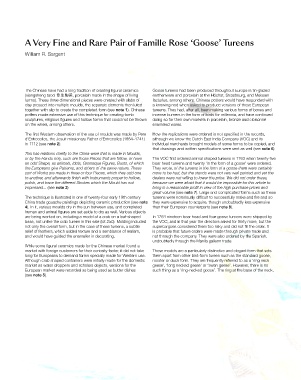Page 222 - Bonhams May 16, 2019 London Asian Art
P. 222
A Very Fine and Rare Pair of Famille Rose ‘Goose’ Tureens
William R. Sargent
The Chinese have had a long tradition of creating figural ceramics Goose tureens had been produced throughout Europe in tin-glazed
(xiangsheng taoci 象生陶瓷, porcelain made in the shape of living earthenware and porcelain at the Höchst, Strasbourg, and Meissen
forms). These three dimensional pieces were created with slabs of factories, among others. Chinese potters would have responded with
clay pressed into multiple moulds, the separate elements then luted a knowing nod when asked to produce versions of these European
together with slip to create the completed form (see note 1). Chinese tureens. They had, after all, been making various forms of boxes and
potters made extensive use of this technique for creating tomb incense burners in the form of birds for millennia, and have continued
sculptures, religious figures and hollow forms that could not be thrown doing so for their own markets in porcelain, bronze and cloisonné
on the wheel, among others. enameled wares.
The first Western observation of the use of moulds was made by Pere How the replications were ordered is not specified in the records,
d’Entrecolles, the Jesuit missionary Father d’Entrecolles (1664–1741) although we know the Dutch East India Company (VOC) and its
in 1712 (see note 2): individual merchants brought models of some forms to be copied, and
that drawings and written specifications were sent as well (see note 6).
This has relations chiefly to the China-ware that is made in Moulds,
or by the Hands only, such are those Pieces that are follow, or have The VOC first ordered animal shaped tureens in 1763 when twenty-five
an odd Shape, as animals, Idols, Grotesque Figures, Busts, of which boar head tureens and twenty ‘in the form of a goose’ were ordered.
the Europeans give Patterns, and others of the same nature. These They wrote, of the tureens in the form of a goose there were certainly
sort of Works are made in three or four Pieces, which they add one more to be had, but the stands were not very well painted and yet the
to another, and afterwards finish with Instruments proper to hollow, dealers were not willing to lower the price. We did not order these,
polish, and trace the different Strokes which the Mould has not because we were afraid that it would be impossible for this article to
impressed... (see note 3) bring in a reasonable profit in view of the high purchase prices and
great volume (see note 7). Large and complicated forms such as these
The technique is illustrated in one of twenty-four early 19th century tureens were notoriously difficult to successfully make and fire and so
China trade gouache paintings depicting ceramic production (see note they were expensive to acquire, though undoubtedly less expensive
4). In it, various moulds dry in the sun between use, and completed than their European counterparts (see note 8).
human and animal figures are set aside to dry as well. Various objects
are being worked on, including a model of a crab on a leaf-shaped In 1764 nineteen boar head and four goose tureens were shipped by
base, not unlike the crab tureen in this sale (lot 250). Molding included the VOC, and in that year the directors asked for thirty more, but the
not only the overall form, but in the case of these tureens, a subtle supercargoes considered them too risky and did not fill the order. It
relief of feathers, which added texture and a semblance of realism, is probable that future orders were made through private trade and
and would have guided the enameller in decorating. not through the company. They were also ordered by the Spanish,
undoubtedly through the Manila galleon trade.
While some figural ceramics made for the Chinese market found a
market with foreign customers for their curiosity factor, it did not take These models are a particularly distinctive and elegant form that sets
long for Europeans to demand forms specially made for Western use. them apart from other bird-form tureen such as the standard goose,
Although crab shaped containers were initially made for the domestic rooster or duck form. They are frequently referred to as a ‘ring neck
market as water droppers and scholars objects, versions for the geese’, ‘long necked geese’ or ‘swan geese’. However, there is no
European market were recorded as being used as butter dishes such thing as a ‘ring-necked goose’. The ring at the base of the neck,
(see note 5).

